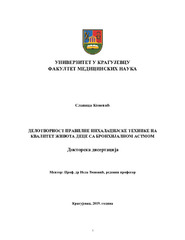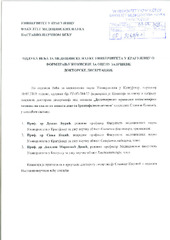Приказ основних података о дисертацији
Delotvornost pravilne inhalacijske tehnike na kvalitet života dece sa bronhijalnom astmom
Effectiveness of correct inhalation technique on the quality of life of children with bronchial asthma
| dc.contributor.advisor | Đonović, Nela | |
| dc.contributor.other | Đurić, Dušan | |
| dc.creator | Konević, Slavica | |
| dc.date.accessioned | 2020-01-27T14:06:12Z | |
| dc.date.available | 2020-01-27T14:06:12Z | |
| dc.date.available | 2020-07-03T15:20:35Z | |
| dc.date.issued | 2019-10-09 | |
| dc.identifier.uri | https://nardus.mpn.gov.rs/handle/123456789/11814 | |
| dc.identifier.uri | http://eteze.kg.ac.rs/application/showtheses?thesesId=7056 | |
| dc.identifier.uri | https://fedorakg.kg.ac.rs/fedora/get/o:1177/bdef:Content/download | |
| dc.description.abstract | Uvod: Astma je vodeća hronična bolest kod dece. Pravilna primena postojećih lekova, uz mere kontrole okoline i uz dobru edukovanost, kod većine pacijenata omogućuje postizanje dobre kontrole bolesti. Ciljevi: Primarni cilj ovog istraživanja bio je da se utvrdi uticaj edukacije dece sa astmom na pravilnu upotrebu inhalera. Drugi cilj je bio razumevanje koji aspekti kvaliteta života mogu biti značajno unapređeni posle edukacije i identifikacija faktora koji utiču na nivo unapređenja. Materijal i metode: Studija je opservaciona, prospektivna, po principu panel studije koja je sprovedena tokom 18 meseci ( od januara 2016 do juna 2017 godine. Studija se odvijala kroz tri faze: prva faza ( prva studija preseka), druga faza (faza edukativne intervencije) i treća faza ( druga studija preseka). Studijska populacija (293 deteta i 293 roditelja) je imala dve grupe bolesnika i članova njihovih porodica: 1. prva grupa (interventna grupa) - 147 pacijenata i isto toliko roditelja koji su podvrgnuti edukativnoj intervenciji o pravilnoj upotrebi inhalera i 2. druga grupa (kontrolna grupa) – 146 pacijenata i isto toliko roditelja prema kojima edukativna intervencija nije bila usmerena. Ispitanici su regrutovani iz populacije dece starosti od 7 do 17 godina. Za merenje funkcionalnih problema koji se najčešće javljaju kod dece sa astmom korišćen je The Pediatric Asthma Quality of Life Questionnaire (PAQLQ), a kvalitet života roditelja meren je PACQLQ upitnikom . Test za kontrolu astme (ACT) korišćen je za utvrđivanje stepena kontrole astme. Takođe mereni su i forsirani eksiratorni volumen u 1 sekundi (FEV1) vršni ekspiratorni protok (PEF). Rezultati: Pre obuke najviše je bilo dece sa nekontrolisanom astmom. Nakon obuke značajno je povećan broj pacijenata koji su imali delimično kontrolisanu astmu, dok se broj dece sa nekontrolisanom smanjio sa 80 na 37(χ2= 28,962; p <0,001). Vanredne posete domu zdravlja smanjene su za 19,1%, izostanci iz škole smanjeni za 18,6% posle sprovedene obuke, što je značajno više u poređenju sa kontrolnom grupom. U interventnoj grupi nađene su statistički značajne razlike u vrednostima skorova PAQLQ, ACT (p <0,001) i FEV1 (p=0,047) pre i posle edukacije. Broj dece koja su pravilno koristila inhaler povećao se sa 28 (19%) na 127 (86.4%) (p<0.001)). U kontrolnoj grupi nisu nađene statistički značajne razlike između posmatranih vrednosti.MANCOVA je 4identifikovala edukaciju (p=0,004), FEV1 (p=0,019), relativno poboljšanje tehnike (p< 0,001) i težinu astme (p< 0,001) kao značajne kovarijante. Na osnovu η2 vrednosti, težina astme je najviše doprinosila razlici u vrednostima PAQLQ i ACT skorova (38,4 %). ANCOVA je dodatno pokazala da pored izdvojenih kovarijanta, na vrednosti skorova kvaliteta života značajno utiče težina astme i to na emocije (32.9%), ograničenje aktivnosti (35.4%), PAQLQ skor (37.3%). Edukacija je imala značajan uticaj na stepen kontrole astme - ACT skor (17.7%) ali takođe sa značajnim uticajem težine astme (24.7%). Za težinu astme negativne vrednosti koeficijenta B ukazuju na negativnu korelaciju između ove kovarijante i vrednosti PAQLQ i ACT skorova..Pozitivne vrednosti koeficijenta B, ukazale su na pozitivan uticaj povećanja FEV1 i poboljšanja inhalacijske tehnike na veće vrednosti PAQLQ i ACT skorova posle edukacije. Kod kontrolne grupe nije bilo statistički značajnih rezultata kada su primenjena MANCOVA i ANCOVA. Potvrđene su korelacije PAQLQ i PACQLQ skorova u interventnoj grupa, što govori o istovremenom pozitivnom efektu ove intervencije na decu i na roditelje. Zaključak: Rezultati istraživanja su ukazali na pozitivan efekat edukacije pacijenata na smanjenje broja grešaka prilikom upotrebe inhalera, a samim tim i na poboljšanje kliničkih pokazatalja respiratorne funkcije. Bolja inhalacijska tehnika kod dece sa astmom više doprinosi boljoj kontoli astme u odnosu na unapređenje kvaliteta života. Najveći uticaj na varijacije i ACT i PAQLQ skorovima ima stepen težine astme, koji se pokazao kao najveća prepreka za unapređenje kvaliteta života kod dece sa astmom. | sr |
| dc.description.abstract | Introduction: Asthma is a leading chronic disease in children. Proper administration of existing drugs, with environmental controls and good education, allows most patients to achieve good disease control. Objectives: The primary objective of this study was to determine the impact of the education of children with asthma on the proper use of inhalers. The secondary objective was to understand what aspects of quality of life can be significantly improved after education and to identify factors that influence the level of improvement. Material and Methods: The study was conducted as an observational, prospective, panelbased study for 18 months (from January 2016 to June 2017) through three phases: the first phase (first cross-sectional study), the second phase (intervention phase – education), and the third phase (second cross-sectional study). We included a total of 293 children and 293 parents who were divided into two groups. The first group (intervention group) included 147 patients and as many parents who were educated on the proper use of inhalers, while the second group (control group) included 146 patients and as many parents who were not targeted by the educational intervention. Respondents were recruited from a population of children aged 7 to 17 years. The Pediatric Asthma Quality of Life Questionnaire (PAQLQ) was used to measure the functional problems that most commonly occur in children with asthma, and the quality of life of parents was measured by the PACQLQ questionnaire. Asthma Control Test (ACT) was used to determine the degree of asthma control. We also measured the forced expiratory volume in the first second (FEV1) and peak expiratory flow (PEF). Results: At the beginning of the study, the majority of children were with uncontrolled asthma. After education, the number of patients with partially controlled asthma increased significantly, while the number of children with uncontrolled decreased from 80 to 37 (χ2 = 28,962; p <0.001). Unscheduled visits to the health care center were reduced by 19.1%, absences from school decreased by 18.6% which is significantly higher compared to the control group. In the intervention group, statistically significant differences were found in the PAQLQ, ACT, (p <0.001) and FEV1 (p = 0.047) scores before and after education while the number of children who used the inhaler correctly increased from 28 (19%) to 127 (86.4%) (p <0.001). No significant differences were observed in the control group between the aforementioned variables. 6We identified education (p = 0.004), FEV1 (p = 0.019), relative technique improvement (p <0.001), and asthma severity (p <0.001) as significant covariates by the MANCOVA test. Based on the η2 values, asthma severity contributed most to the difference in PAQLQ and ACT scores (38.4%). Furthermore, the ANCOVA test showed that the values of the quality of life score were significantly influenced by the severity of asthma - on emotions (32.9%), activity restriction (35.4%) and PAQLQ score (37.3%). Education had a significant impact on the degree of asthma control - ACT score (17.7%) but also with a significant impact of asthma severity (24.7%). An inverse correlation between asthma severity and PAQLQ and ACT scores was shown while increasing FEV1 and improving inhalation techniques resulted in an increase in PAQLQ and ACT scores after education. There were no statistically significant differences in the control group when MANCOVA and ANCOVA tests were applied. Correlations of PAQLQ and PACQLQ scores in the intervention group were confirmed, suggesting a concurrent positive effect of education as an intervention on both children and parents. Conclusion: The results of our study indicated a positive effect of patient education on reducing the number of errors during inhalation and therefore on improving the clinical indicators of respiratory function. Better inhalation techniques in children with asthma contribute more to better asthma control than to the quality of life improvement. The major impact on variations in both ACT and PAQLQ scores had the severity of asthma which proved to be the biggest barrier to improving the quality of life of children with asthma. | en |
| dc.format | application/pdf | |
| dc.language | sr | |
| dc.publisher | Универзитет у Крагујевцу, Факултет медицинских наука | sr |
| dc.relation | info:eu-repo/grantAgreement/MESTD/Basic Research (BR or ON)/175046/RS// | |
| dc.rights | openAccess | en |
| dc.rights.uri | https://creativecommons.org/licenses/by-nc-nd/4.0/ | |
| dc.source | Универзитет у Крагујевцу | sr |
| dc.subject | kontrola astme | sr |
| dc.subject | asthma control | en |
| dc.subject | FEV1 | en |
| dc.subject | primary care | en |
| dc.subject | education | en |
| dc.subject | FEV1 | sr |
| dc.subject | primarna zdravstvena zaštita | sr |
| dc.subject | edukacija | sr |
| dc.title | Delotvornost pravilne inhalacijske tehnike na kvalitet života dece sa bronhijalnom astmom | sr |
| dc.title.alternative | Effectiveness of correct inhalation technique on the quality of life of children with bronchial asthma | en |
| dc.type | doctoralThesis | en |
| dc.rights.license | BY-NC-ND | |
| dc.identifier.fulltext | https://nardus.mpn.gov.rs/bitstream/id/50267/Disertacija.pdf | |
| dc.identifier.fulltext | https://nardus.mpn.gov.rs/bitstream/id/50268/Slavica_Konevic_Medicina.pdf | |
| dc.identifier.fulltext | http://nardus.mpn.gov.rs/bitstream/id/50267/Disertacija.pdf | |
| dc.identifier.fulltext | http://nardus.mpn.gov.rs/bitstream/id/50268/Slavica_Konevic_Medicina.pdf | |
| dc.identifier.rcub | https://hdl.handle.net/21.15107/rcub_nardus_11814 |



